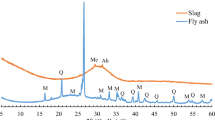Abstract
The fluoride ion is crystal chemically very similar to the hydroxyl ion, substituting for hydroxyl in many minerals in which hydrogen bonding is not important. Fluoride substitutions are particularly common in 2:1 layer silicates, such as micas, illites and smectites. The brick and tile industries, which use naturally occurring clays as their primary raw materials, have devoted considerable effort to understanding fluorine evolution during firing of the raw materials due to increasingly stringent fluorine emission regulations. In order to understand fluorine evolution from ceramic raw materials, we have studied a number of phyllosilicate materials used in making bricks. X-ray powder diffraction and fluorine analyses were combined with heating experiments and thermogravimetric analysis to evaluate the chemical and structural changes taking place on heating. Fluorine remained in 2:1 layer silicates to higher temperatures than did hydroxyl, but it behaved identically to hydroxyl in the kaolinite studied. In all cases, fluorine evolution coincided with structural breakdown of the clay host. These results show that fluorine evolution will consistently occur during firing of clay raw materials, and the problems of fluorine emission cannot be readily solved by simple variations of firing temperatures or times.
Similar content being viewed by others
References
Bassett, W.A. (1960) Role of hydroxyl orientation in mica alteration. Bulletin of the Geological Society of America, 71, 449–456.
Bish, D.L., Vaniman, D.T. and Chipera, S.J. (1999) Effects of particle size and trace-mineral content on kaolin trace element chemistry. Proceedings of the 36th Annual Clay Minerals Society Meeting, p. 15.
Chipera, S.J. and Bish, D.L. (1989) The nature of fluorine in a partially ordered I/S clay. Proceedings of the 25th Annual Clay Minerals Society meeting, p. 23.
Chipera, S.J., Guthrie, G.D., Jr. and Bish, D.L. (1993) Preparation and Purification of Mineral Dusts. Pp. 235–249 in: Health Effects of Mineral Dusts (G.D. Guthrie and B.T. Mossman, editors). Reviews in Mineralogy, 28. Mineralogical Society of America, Washington, D.C.
Chung, F.H. (1974) Quantitative interpretation of X-ray diffraction patterns of mixtures. II: Adiabatic principle of X-ray diffraction analysis of mixtures. Journal of Applied Crystallography, 7, 526–531.
Clarke, F.W. and Washington, H.S. (1924) The composition of the earth’s crust. U.S. Geological Survey Professional Paper 125, as referenced in Robinson and Edgington (1946).
Eagers, R.Y. (1969) Toxic Properties of Inorganic Fluorine Compounds. Elsevier, New York, 152 pp.
Giese, R.F., Jr. (1975) The effect of F/OH substitution on some layer-silicate minerals. Zeitschrift für Kristallographie, 141, 138–144.
Giese, R.F. (1978) The electrostatic interlayer forces of layer structure minerals. Clays and Clay Minerals, 26, 51–57.
Giese, R.F., Jr. (1982) Theoretical studies of the kaolin minerals. Electrostatic calculations. Bulletin de Mineralogie, 105, 417–424.
Hauck, D. and Hilker, E. (1986) Possibilities for the reduction of fluorine emission in the firing of bricks and tiles. Ziegelindustrie International, 7–8/86, 373–385.
Hazen, R.M. and Burnham, C.W. (1973) The crystal structures of one-layer phlogopite and annite. American Mineralogist, 58, 889–900.
Ingram, B.L. (1970) Determination of fluoride in silicate rocks without separation of aluminum using a specific ion electrode. Analytical Chemistry, 42, 1825–1827.
Joswig, W. (1972) Neutronenbeugungsmessungen an einem 1M-phlogopit. Neues Jahrbuch für Mineralogie-Monatshefte, 1–11.
Keller, W.D. (1986) Compositions of condensates from heated clay minerals and shales. American Mineralogist, 71, 1420–1425.
Kerr, P.F. and Kulp, J.L. (1949) Reference Clay Localities — United States. American Petroleum Institute Project 49 (Clay Minerals Standards), Preliminary Report 2, 101 pp.
Kolkmeier, H. (1986) Emission control in the brick and tile industry. Ziegelindustrie International, 10/86, 516–530.
Labouriau, A., Kim, Y.-W., Chipera, S.J., Bish, D.L. and Earl, W.L. (1995) A 19F nuclear magnetic resonance study of natural clays. Clays and Clay Minerals, 43, 697–704.
Mumenthaler, T., Schmitt, H.W., Peters, T., Ramseyer, K. and Zweili, F. (1995) Tracing the reaction processes during firing of carbonate-containing brick mixes with the help of cathodoluminescence. Ziegelindustrie International, 5/95, 307–318.
Ohashi, Y. and Burnham, C.W. (1972) Electrostatic and repulsive energies of the M1 and M2 cation sites in pyroxenes. Journal of Geophysical Research, 77, 5761–5766.
Reynolds, R.C., Jr. and Reynolds, R.C., III (1987) Description of program NEWMOD for the calculation of the one-dimensional X-ray diffraction patterns of mixed-layered clays. Department of Earth Sciences, Dartmouth College, Hanover, New Hampshire.
Robinson, W.O. and Edgington, G. (1946) Fluorine in soils. Soil Science, 61, 341–353.
Romo, L.A. and Roy, R. (1957) Studies of the substitution of OH− by F− in various hydroxylic minerals. American Mineralogist, 42, 165–177.
Rothbauer, R. (1971) Untersuchung eines 2M1-muskovits mit neutronenstrahlen. Neues Jahrbuch für Mineralogie-Monatshefte, 143–154.
Sedej, B. (1988) The emission of volatile fluorides during the process in the ceramic industry. Ziegelindustrie International, 7–8/88, 372–376.
Steinkoenig, L.A. (1919) The relation of fluorine in soils, plants, and animals. Journal of Industrial and Engineering Chemistry, 11, 463, as referenced in Robinson and Edgington (1946).
Storer-Folt, J.A., Cooper, D.J. and Boeck, E. (1992) Fluorine release in a brick tunnel kiln. Ceramic Bulletin, 71, 636–638.
Strohmenger, W. (1983) Problems associated with fluorine. Ziegelindustrie International, 2/83, 67–72.
Sugiyama, H., Ōya, A. and Ōtani, S. (1988) Syntheses and thermal degradation behaviours of saponite-α-naphthylamine complexes: Effects of substitution of OH in saponite by fluorine. Journal of Materials Science, 23, 1764–1768.
Thomas, J., Jr., Glass, H.D., White, W.A. and Trandel, R.M. (1977) Fluorine content of clay minerals and argillaceous earth materials. Clays and Clay Minerals, 25, 278–284.
Troll, G., Farzaneh, A. and Cammann, K. (1977) Rapid determination of fluoride in mineral and rock samples using an ion-selective electrode. Chemical Geology, 20, 295–305.
Wilson, H.H. and Johnson, L.D. (1975) Characterization of air pollutants emitted from brick plant kilns. Ceramic Bulletin, 54, 990–993.
Wolfe, R.W. and Giese, R.F., Jr. (1978) The stability of fluorine analogues of kaolinite. Clays and Clay Minerals, 26, 76–78.
Author information
Authors and Affiliations
Corresponding author
Rights and permissions
About this article
Cite this article
Chipera, S.J., Bish, D.L. Thermal evolution of fluorine from smectite and kaolinite. Clays Clay Miner. 50, 38–46 (2002). https://doi.org/10.1346/000986002761002658
Received:
Revised:
Published:
Issue Date:
DOI: https://doi.org/10.1346/000986002761002658




